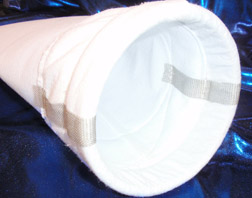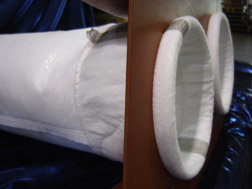Grounding Issues
As dusts are drawn or blown into a bag house, they carry with them a static electric charge, the magnitude of which depends on the characteristics of the dust and the process. The charge will remain on the dust and will accumulate on the surface of the bags. This static is potentially hazardous, causing explosions and poor dust release. It is important to keep all conductive equipment grounded to prevent the induction of this charge onto conductive components that could have become ungrounded. This is particularly true in the cage assemblies. To prevent static, solutions include anti-static chemical treatments, using felt with stainless steel fiber blends, or adding ground wires to the filter bags.
NFPA 77 covers the subject of static electricity and its hazards. It reflects the level of understanding of static electricity and presents considerable information that explains the fundamental aspects of the phenomenon and recommendations for evaluating and controlling potential hazards. New information has been provided to address specific hazards of flammable gases and vapors and combustible dusts and also to address specific industrial processes and operations. It also provides the user with acceptable methods of grounding, correcting the mistaken belief that the ground wire needs to run the length of the bag.
NFPA 77 states the following:
"Bags and cages should be engineered so that a positive ground connection is always maintained. One way of doing this is by sewing two metal braids into the cuffs of the bags, 180 degrees apart. Each braid is continuous and is sewn up the inside of the cuff, across the top, and down the outside of the cuff. Therefore, the braids will always make a positive contact with the cage and will withstand the rigors of the operations. Because the bag is nonconductive, the bag itself is not grounded. It is therefore useless to extend the metal braid down the entire length of the bag.
There is no evidence that filter bags made from conductive or antistatic fabric is needed to prevent incendive discharges. On the contrary, such bags could create discharge hazards if sections of the fabric become isolated or if a bag falls into the bottom of the bag house (NFPA 77, 8.9.2 and 8.9.3, 2000 Edtn)."
|
|
|
|
|
|
|
|


|
|
|
|
|
|
If you have a problem with static buildup in your baghouse, Day Filters. offers various options to solve this condition. Contact Us and we will perform a thorough risk evaluation at your facility to identify and eliminate factors that could contribute to an explosion. This is one of the mandatory requirements set forth in the NFPA standards for the handling of combustible dusts, which are now being enforced by OSHA and local authorities. |
|